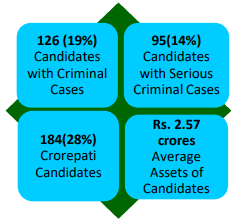The fifth phase of Lok Sabha elections will be held on May 6th in 51 constituencies across Bihar, Jammu and Kashmir, Uttar Pradesh, Jharkhand, Madhya Pradesh, Rajasthan and West Bengal. The Association for Democratic Reforms (ADR) has published its comprehensive analysis of candidates contesting in this phase.
In a first, around 12% of the candidates in the fray on May 6th are women. This is the highest percentage of women so far and surpasses the previous four phases of elections. It is five percentage points higher than the 7% representation seen in the first phase. However, in absolute terms, women continue to form a minority even in the upcoming phase.
In fact, several contesting candidates in this phase have declared criminal cases for offences or crimes against women. Nine candidates have declared cases related to crime against women including rape and causing miscarriage without the woman’s consent.
Overall, however, there has been a dip in the number of candidates with criminal cases compared to the previous phases of the 2019 elections. In all, 126 (19%) out of 668 candidates analysed for the fifth phase have declared criminal cases against themselves. Among these, 95 (14%) have declared serious criminal cases. 3 candidates have cases related to murder against themselves.
There are also less candidates in this phase with assets over Rs 1 crore. 184 (28%) candidates have assets worth Rs 1 crore and more. Among the major parties 38 (79%) out of 48 candidates from BJP, 32 (71%) out of 45 candidates from INC,17 (52%) out of 33 candidates from BSP, 8 (89%) out of 9 candidates from SP and 31 (12%) out of 252 independent candidates have declared assets worth more than Rs 1 crore.
Jayant Sinha of BJP is the candidate with the highest income. He is contesting from Hazaribagh in Jharkhand and has a total income of Rs 5.72 crore. This includes the incomes of his spouse and dependents. His assets are worth Rs 77 crore.
However, this doesn’t make Jayant Sinha the richest of the candidates. Poonam Sinha, wife of former actor and politician Shatrughan Sinha is the richest, with assets amounting to Rs 193 crore. She is contesting as a Samajwadi Party candidate from Lucknow, Uttar Pradesh.
Three candidates have declared zero assets. This includes Narayan Das Jatav, Guru Gokulchand Rashtarwadi and Munni from Madhya Pradesh, Rajasthan and Uttar Pradesh respectively.
264 (40%) candidates have declared their educational qualification to be between 5th and 12th. 348 (52%) candidates have declared having an educational qualification of graduate or above. 43 candidates have declared themselves as just literate and six candidates are illiterate.
Read the full ADR report here.

